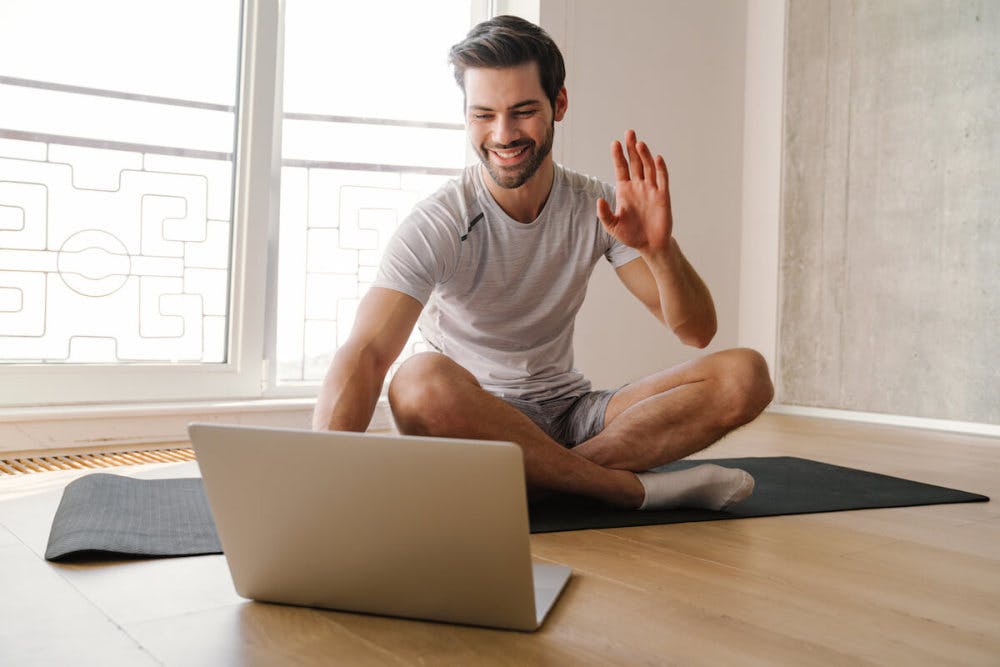How to Set Achievable Fitness Goals for Women and Get Results
Our content strives to support, inform, and motivate you to meet your health goals. We want to be your trusted source of expert- and science-backed info dispensed in simple, actionable ways. Read our Editorial Guidelines.
Having #fitnessgoals is commendable, but how often are these goals actually achievable? We often expect too much of ourselves when starting a new exercise routine.
Not to worry! We’re here to help you learn how to create achievable fitness goals that make sense for you.
Read on to learn how to set smart goals, some examples of fitness goals for women (and others), how to choose the best goals for you, and how an online personal trainer can help you on your fitness journey.
How to Set SMART Goals

We’ve all been there: super excited and amped up about some new workout routine, then super sore, then generally discouraged. Maybe that YouTube video made kettlebell swings look a lot easier than they really were!
Here, we’re going to help you avoid these situations by setting goals that are SMART: specific, measurable, achievable, relevant, and time-bound.
Specific
So, say you’ve decided to work on upper body strength training. How will you do this, and why do you want to? What sort of training will you do? Where and when will you train? Who could help you achieve your goals? Do you need any special equipment? These are the sorts of specific questions it helps to ask yourself when setting any sort of goal.
Let’s say you decide to start doing more push-ups, since you already know how to do them and bodyweight exercises don’t need any equipment or space. Nice! Daily push-ups have many benefits, and you don’t need dumbbells or a barbell or anything remotely fancy.
Measurable
Deciding to do more push-ups is all well and good, but you need a measurable target so you can track your progress (and celebrate when you meet your targets!). Maybe you want to eventually be able to do 20 push-ups a day. Maybe you can already do 20 but you’d like to do 50. Maybe you want to work your way from 20 knee push-ups to 20 regular push-ups.
When possible, try to attach specific numbers to goals. For example:
Jog for 30 minutes 3-4 times a week
Do 10 curl-ups 6 mornings a week
Do a 20-minute high-intensity interval training (HIIT) workout twice a week
Achievable
So, how many push-ups can you currently do? To set achievable goals, you need to give yourself time to progress. Maybe try adding 1 rep per week, or 5 every other week — whatever seems achievable right now!
Setting achievable goals can make the difference between persevering and giving up.
Additionally, consider that “increasing the number of push-ups I can do” is achievable, while “have nicer-looking arms” may not be. For one thing, it's subjective! Attach goals to the specific actions rather than results.
You may indeed look better as a result of your workout routine, but this is a secondary result of your workouts and not entirely within your control.
Relevant
A relevant goal makes sense for you based on your fitness level and challenges you might be facing. For example, everyone can benefit from strength training, but older women in particular may benefit from high-intensity resistance training to help prevent (or recover from) osteoporosis.
Other areas, like strength training, are relevant for everyone. For example, research shows it can help with body composition, chronic disease risk, mental health, and overall health.
Think about why you want to build upper body strength: to carry heavy objects (or small children!) more easily, to protect yourself from injury, to protect against disease, etc. Consider what motivates you most to help you determine why your goal is relevant.
Time-Bound
A time-bound goal looks at when you want to reach your target. A trainer or other online resources can help you determine what a realistic timeline looks like for your goals.
You can always adjust your time goals depending on how fast you’re improving. Be aware of your progress from week to week and consider how many additional weeks it might take to reach your next benchmark.
5 Examples of Fitness Goals for Women

We’re including some samples of what a SMART fitness goal might look like, but keep in mind this is not an exhaustive list. You can include any physical activity that gets your heart rate up – and that you enjoy.
1. Learn X New Yoga Poses a Month
Dynamic stretching (stretching based on movement) such as yoga can be very beneficial. As explained by Dr. Anne Rex of the Cleveland Clinic, dynamic stretching can warm up the muscles and improve circulation. It can also increase power as well as jumping and sprinting performance. It’s a great addition to any exercise routine.
Consider trying a few new yoga poses each month (or week, or whatever time frame you prefer).
2. Run or Walk In Nature X Times per Week
Running is already known to provide many health benefits, but running in nature – also called “green exercise” – can improve overall health even more than running on a treadmill. Simply being in nature can improve cognitive function and mental health.
If the scenery around you isn’t so beautiful, watching pleasant videos of nature may have benefits.
3. Do 10-20 Minute HIIT Workouts 2-3 Times Per Week
HIIT workouts alternate short bursts of high-intensity exercise with short intervals of rest or light exercise. They are incredibly beneficial, potentially even more so than moderate cardio workouts.
Because these workouts are high-intensity, stick to no more than 2-3 per week. When you’re ready to progress, you can increase the time of each interval (or of the whole workout), or add more intensity to individual exercises, etc.
4. Aim to Sleep for 7-9 Hours Every Night
Yes, this is a fitness goal. Sleep is absolutely essential for recovery from exercise and physical activity.
In fact, sleep loss among athletes can worsen both physical and cognitive performance. It can even contribute to overtraining syndrome, which is when excessive training leads to declining performance.
5. Drink 2-4 Liters of Water Every Day
As with lack of sleep, your fitness journey can be derailed by not staying hydrated. Exercise can increase your hydration needs, since it often causes you to sweat.
According to the Mayo Clinic, women should aim to drink about 2.7 liters of water per day, while men should aim for 3.7 liters (though some of this comes from foods and beverages that contain water).
Of course, since athletes lose both water and electrolytes during training sessions, make sure you replenish electrolytes as well.
How to Choose the Best Fitness Goals for You

Now that you’ve seen some samples of fitness goals, which one(s) should you choose? Only you can answer this question – but we can offer some general advice.
It helps to start with the FITTE principle: frequency, intensity, time, type, and enjoyment.
Frequency
For each exercise goal, consider how many times per week (or day, or month) you’d like to do the exercise. This will depend somewhat on your schedule, so think about what’s feasible for you.
Keep in mind that some types of high-intensity exercise like HIIT workouts, lifting weights, and sprinting should be limited to 2-3 times per week to give yourself adequate time to recover. Other types of lower intensity exercise, like walking, are things you can do every day – if your schedule allows.
Intensity
Different types of exercise can be performed at different levels of intensity. For instance, walking, jogging, running, and sprinting are all different intensity levels of the same basic type of exercise. Lifting weights is usually high intensity, but the intensity can be lowered by using lighter weights.
You can adjust your intensity by carrying dumbbells, trying to increase your speed, etc. Consider what intensity level for each exercise is appropriate for you, and adjust accordingly.
Keep in mind intensity level will also impact frequency, and vice versa. For instance, if most of your exercises are low intensity, you may want to build in more workouts per week.
Time
Time refers to the duration of each workout or training session. The CDC recommends 150 minutes of moderate physical activity a week, so just doing a plank or pull-up every day won’t give you enough active minutes (though it’s a great place to start!). Walking or hiking is a good way to add more active minutes to your week.
Type
You’ll get more benefits from a variety of types of exercise. Aim to target at least a couple of different exercises when coming up with fitness goals, and make sure to include cardio, strength training, and flexibility.
You’ll also want to think about what sort of exercise you’d like to prioritize based on any broader health goals, such as building upper body strength or increasing stamina.
Enjoyment
Perhaps the most overlooked factor: Think about exercise you would enjoy. If you hate most cardio workouts but love dancing, look at dancing workouts like Zumba.
If you’ve always wanted to try rock climbing, or go backpacking, or learn about Pilates, go for it! And if you have access to green areas and enjoy being in nature, try doing some of your exercises there. Blast whatever music gets you pumped (via headphones if you’re in public).
Remember, the most effective workout plan is the one you do. If you find something you enjoy, you’re much more likely to be motivated to do it.
Work with an Online Personal Trainer to Help You Set and Achieve Goals

As we’ve seen, there are many factors to consider when determining the best fitness goals for you. To come up with realistic goals, use the SMART guidelines and the FITTE principles to help customize your plan to your needs and preferences. Start small, and gradually add to your goals over time.
For professional guidance with setting and achieving your fitness goals, beginners and long-time gym rats should consider working with an online personal trainer from Kickoff. It’s much more cost effective than working with an in-person trainer, not to mention more convenient.
You can do your workouts from home or wherever you like to exercise. Plus, with so many trainers available, you'll surely find someone whose schedule, personality, and general approach is a perfect match.